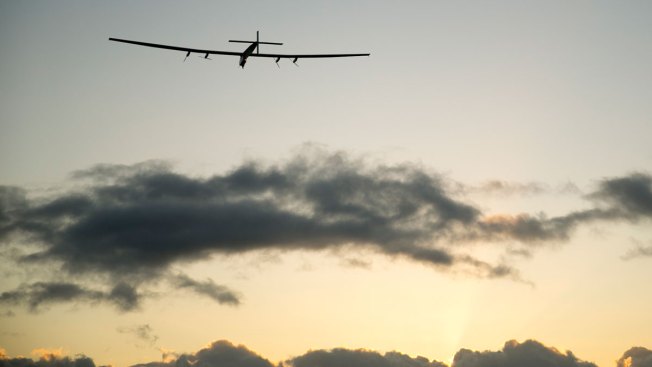
Posted on 04/22/2016 1:15:45 AM PDT by nickcarraway
The plane was on course to land in Mountain View, California, in about three days
Two pilots are slowly carving their way into a new future of solar-powered flight as one embarks on the latest leg of their around-the-world journey in a plane powered only by the sun.
After some uncertainty about winds, the Solar Impulse team took off from Hawaii on Thursday, and hours later it was still ascending over the Pacific attempting to reach a high altitude before night sets in.
The Swiss-made Solar Impulse 2 was on course to land in Mountain View, California, in about three days. The crew that helped it take off was clearing out of its Hawaiian hangar and headed for the mainland for the weekend arrival.
(Excerpt) Read more at nbcbayarea.com ...

I hope they make it
> The crew that helped it take off was clearing out of its
> Hawaiian hangar and headed for the mainland for the weekend
> arrival.
Let me guess.
They took a commercial flight using thousands of pounds of “fossil” fuel to get to the mainland before their solar powered buddies.
Best not fly too close to the sun.
Hope they didn’t name the plane ‘Icarus’.
Hope they have the super size Depends daipers on.
That will be one smelly cockpit when they land.
That has some value commercially if they put that system of propulsion in a rigid airship.
Yep, in the future, all aircraft will be solar powered. The problem is carrying only one passenger at a time for four or five days.
Barking up the wrong tree. When coon hunting the dog’s ability is everything
Unfortunately we are the ones being treed by the climate push tingly leg agenda.
The success of this flight won't be measured by its departure.
Taking off is easy, it’s the landing that’s difficult.
I think their potential value will be as atmospheric communications satellites.
To carry 200 passengers how big would they have to make one of those?

when the solar plane didn't take off.
The neatest thing about solar planes is how high they can fly. One got up to about 100,000 feet.
Well, it needs to be that high, because night.
When the sun sets it gets dark and the solar power is no more, and the only electricity they have is from batteries.
So it will consume the batteries until such time as the sun comes up. If they exhaust the batteries before that time they can avoid an early splash down by being high up to begin with.
Still, wonder how long this thing can glide at night? Higher altitude means less lift, no?
And reconnaissance drones. There are advantages to being able to stay on station for days.
I tried some searches and it was surprisingly hard to find the information I wanted. Glide slope is the issue when there is no power and you are gradually losing altitude. So you have to aim the plane downward to prevent stalling and lose altitude at a calculated rate. This plane is surely mostly glider and has a very very shallow glide slope all of which has been carefully calculated given an expected altitude as solar energy goes away. I'm not a pilot and I'm sure some Freeper pilot will correct if needed.
And the point of this is?...
Just saying they run their motors at a rate that will minimize their sink rate for the time in darkness. Just a guess.
Disclaimer: Opinions posted on Free Republic are those of the individual posters and do not necessarily represent the opinion of Free Republic or its management. All materials posted herein are protected by copyright law and the exemption for fair use of copyrighted works.